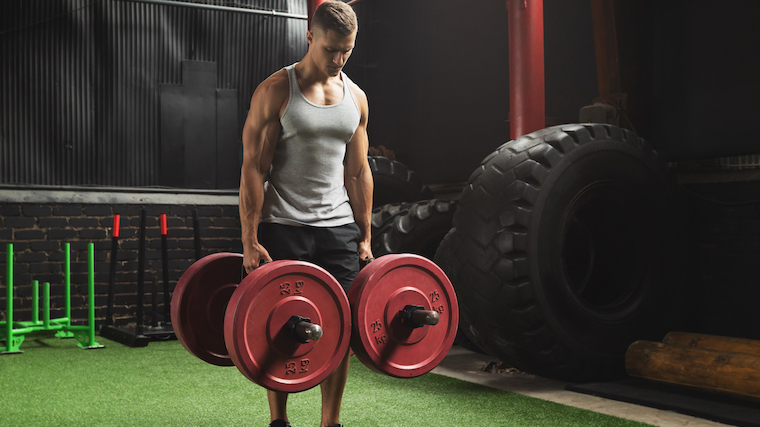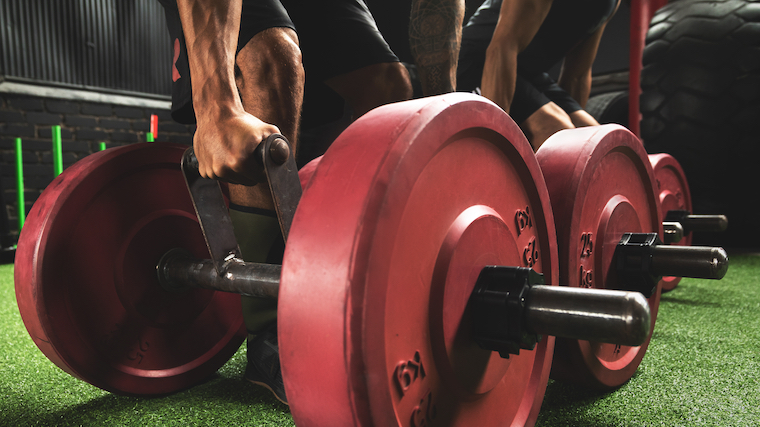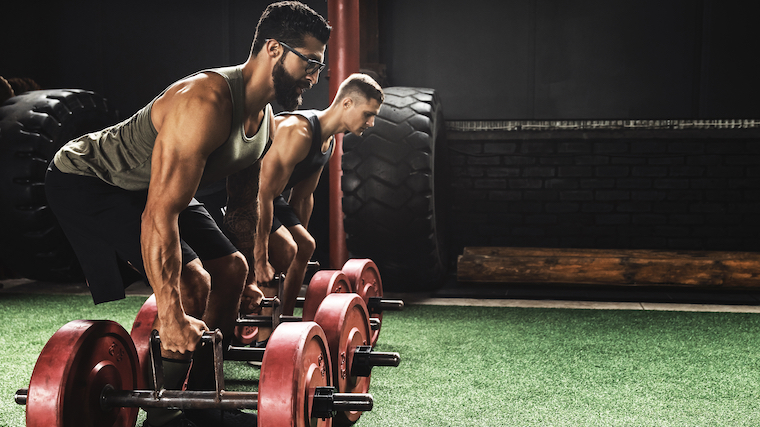One of the best exercises for you may also be one of the most simplistic. The farmer’s walk has you pick up a pair of barbells loaded with weight plates, dumbbells, kettlebells, or specific farmer walk handles, and simply stroll forwards. Stabilizing the weights while taking a stroll requires a lot of coordination, balance, grip strength, and core strength. Does it sound easy? Yes. Is it easy? Heck no — especially if you do it right.
Below is a how-to on performing the farmer’s walk — a move lauded by strength sports athletes everywhere, and performed in strongman competitions — along with six benefits of walking it out.
6 Benefits of Farmer’s Walks
- Strengthen Grip
- Gain Muscle Mass
- Increase Postural Strength and Control
- Enhance Core Stabilization and Bracing
- Develop Athleticism
- Maximize Pulling Strength
Editor’s note: The content on BarBend is meant to be informative in nature, but it shouldn’t take the place of advice and/or supervision from a medical professional. The opinions and articles on this site are not intended to diagnose, prevent, and/or treat health problems. Speak with your physician if you have any concerns.

[Related: What You Need to Know About How to Increase Strength]
How to Do the Farmer’s Walk
Before diving into the six benefits athletes can expect from training with farmer’s walks, let’s break down how to do them properly. Once the implements are loaded with the desired weight, stand between them and grip the handles’ center. The correct position for the hands should be directly under the shoulders.
The lift before walking is akin to a neutral grip deadlift — it should be one fluid motion to the upright position with the core braced and the back “packed” (read: scapula depressed and engaged). When walking, the challenge is to maintain a steady, upright position and not allow the weight to tip one side or move laterally. Imagine the barbells are on rails, and you are walking them along those rails.
Don’t fall into the trap of flaring the elbows or shoulders. Athletes who are unfamiliar or new to farmer’s walks might tend to do a pseudo lateral raise with the implements, so they aren’t too close to the legs as they walk — don’t do that. Keep the arms straight with the hands under the shoulders with the idea of keeping the implements tight to the body. The walking path should be straight, narrow, and naturally undisrupted by the implements.

[Related: 24 Deadlift Variations for Muscle, Strength, Speed, Grip Strength, and More]
Farmer’s Walk Benefits
Any athlete can benefit from farmer’s walks and customize the movement to their needs. The load, object shape, distance, time, intensity, frequency, and volume are all variables in the athlete’s control. From strongman to powerlifting to functional fitness, farmer’s walks are worth adding to most training regimens.
1. Strengthen Grip
It may seem obvious that the largest benefit of farmer’s walks is a stronger grip. That’s because it is. Gripping heavily loaded implements is the only part of the farmer’s walk present to the movement regardless of the other variables. An athlete can change the weight, distance, speed, and intensity, but grip requirements will remain the same.
The benefits of a grip strengthened by farmer’s walks translate well to other big lifts, like the deadlift or snatch. Additionally, it can improve accessory movements like dumbbell rows, upright rows, and pull-ups.
2. Stronger Glutes
Of course, the grip gains will lead to strengthened forearms and shoulders, but farmer’s walks have also shown to increase the strength of the glutes, according to a 2015 study in the Journal of Human Kinetics. (1) To maximize the benefits to the glutes and overall performance in the farmer’s walk, athletes should aim for “greater stride length…stride rate and reduced ground contact time.” (2) The recommended workout are sets of six unbroken farmer’s walks with 75 percent of maximum load.

[Related: The Ultimate Workout Split to Build Strength and Muscle Mass]
3. Increase Postural Strength and Control
When carrying loads while walking, postural control is necessary to ensure the integrity of the spine. Farmer’s walks train the deeper tissues around the spine, enhancing movement patterning, postural strength, and control in movements like squats, presses, and deadlifts.
Additionally, farmer’s walks can function as a substitute for deadlifts for “generating more anterior-propulsive and vertical force with less stress to the lumbar spine.” (3) Due to the more vertical trunk position when performing a farmer’s walk, the stress applied to the lumbar spine (or lower back) is less than that of a deadlift assuming both lifts are performed with 70 percent of the athlete’s one-rep max deadlift.
4. Enhance Core Stabilization and Bracing
The core stabilization and bracing benefits gained from farmer’s walks could also be described as the ability to resist spinal rotation, flexion, and extension. That means that maintaining a rigid spine throughout the walk challenges the core and the athlete’s capacity to brace during the movement. Doing so is key to injury prevention and force production.
The practice of bracing the core during farmer’s walks can result in both a stronger trunk extension and hip extension and an increase in maximal lifting power. (4) Additionally, the core bracing during farmer’s walks can increase the muscle thickness of the internal obliques.

[Related: Build a Seriously Strong Posterior Chain With the Good Morning]
5. Develop Athleticism
The enhanced balance and coordination needed to maneuver while carrying heavy objects can translate to improving non-linear movements often seen in strongman and functional fitness competition. Additionally, they can improve day-to-day practices such as carrying groceries and lifting boxes without fatiguing as quickly.
The numbers supporting the farmer’s walk as a routine exercise for strongman athletes are significant. A study in the Journal of Strength and Conditioning Research found one of the most common exercises performed by 167 competitive strongmen to “increase muscular size and development maximal strength and power” is the farmer’s walk. (5) Other notable exercises used were the log press and Atlas stones.
6. Maximize Pulling Strength
The initial lift of a farmer’s walk is akin to a deadlift (i.e., a pulling movement). Practicing farmer’s walks to increase grip and core strength will positively impact overall pulling power in accessory exercises like bent-over barbell rows, Penlay rows, and lat pulldowns where the weight is often not as heavy as a farmer’s walk.
Go For a Farmer’s Walk
Farmer’s walks are a tried and tested staple of strongman training and an effective way to increase grip and core strength, pack on muscle, and improve posture. They are great for competitive athletes aiming to get stronger and casual gym-goers looking to perform exercises that will improve their mechanics for day-to-day activities.
References
- Petr Stastny, et al. The Gluteus Medius Vs. Thigh Muscles Strength Ratio and Their Relation to Electromyography Amplitude During a Farmer’s Walk Exercise. 2015. Journal of Human Kinetics. doi: 10.1515/hukin-2015-0016
- Benjamin R. Hindle, et al. The Biomechanics and Applications of Strongman Exercises: a Systematic Review. 2019. Sports Medicine-Open. doi: 10.1186/s40798-019-0222-z
- Paul W. Winwood, et al. A Biomechanical Analysis of the Farmers Walk, and Comparison with the Deadlift and Unloaded Walk. 2014. International Journal of Sports Science & Coaching. doi.org/10.1260/1747-9541.9.5.1127
- Kota Tayashiki, et al. Effect of abdominal bracing training on strength and power of trunk and lower limb muscles. 2016. European Journal of Applied Physiology. doi: 10.1007/s00421-016-3424-9
- Paul W Winwood, et al. The strength and conditioning practices of strongman competitors. 2011. Journal of Strength and Conditioning Research. doi: 10.1519/JSC.0b013e318212daea
Featured Image: Shutterstock/BLACKDAY